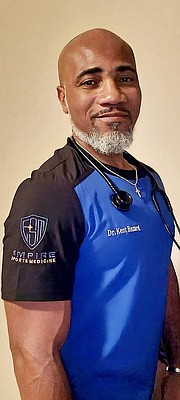By DR KENT BAZARD
IN the intricate tapestry of sports-related injuries, few conditions present as vexing a challenge as the enigmatic sports hernia. Defined by its elusive nature and ambiguous symptoms, sports hernia poses a significant diagnostic and therapeutic dilemma for athletes and clinicians alike.
In this discourse, we delve deeper into the realm of sports hernia, shedding light on its prevalence in specific sports, the biomechanical underpinnings of injury, and the athlete’s presenting complaints.
Prevalence in Sports and Athlete Presentations
While sports hernia can affect athletes across various disciplines, it is commonly observed in sports that involve rapid changes in direction, sudden accelerations, and high-impact movements.
Athletes participating in sports such as soccer, ice hockey, football, and rugby are particularly susceptible due to the dynamic nature of their movements and the repetitive stress placed on the groin and pelvic region.
Athletes presenting with sports hernia often describe a constellation of symptoms, including:
Groin Pain: The hallmark symptom of sports hernia, groin pain typically manifests as a dull, aching sensation that worsens with physical activity, especially during movements involving twisting, turning, or kicking.
Pelvic Discomfort: Athletes may experience discomfort or tenderness in the lower abdomen, pelvic region, or inner thigh, often exacerbated by activities that engage the core musculature or adductor muscles.
Decreased Athletic Performance: Sports hernia can impair athletic performance, leading to diminished speed, agility, and power output. Athletes may notice a decline in their ability to perform explosive movements or change direction with precision.
Biomechanical Mechanisms of Injury: Understanding the biomechanics of sports hernia is crucial for elucidating its underlying pathophysiology and developing targeted prevention and treatment strategies.
The mechanism of injury often involves a combination of factors, including:
Repetitive Stress: Prolonged and repetitive stress on the muscles and tendons surrounding the groin and pelvic region can lead to microtrauma and tissue degeneration, predisposing athletes to sports hernia.
Muscle Imbalance: Imbalances in muscle strength and flexibility, particularly between the adductor muscles and the abdominal wall, can disrupt the dynamic stability of the pelvis and increase the risk of injury during high-velocity movements.
Poor Biomechanics: Faulty movement patterns and biomechanical deficiencies, such as excessive pelvic tilt or inadequate core stabilization, can place undue strain on the soft tissues of the groin and contribute to the development of sports hernia.
Developing a Management Protocol
In managing sports hernia, a multidisciplinary approach is essential, involving collaboration between sports medicine physicians, physical therapists, and sometimes, surgeons. The management protocol typically consists of:
Conservative Treatment: Initial management focuses on conservative measures, including rest, ice, physical therapy, and anti-inflammatory medications. Specific exercises targeting core strength, pelvic stability, and hip mobility are often prescribed to alleviate symptoms and facilitate recovery.
Injection Therapies: In cases refractory to conservative measures, injection therapies, such as corticosteroid injections or platelet-rich plasma (PRP) injections, may be considered to reduce inflammation and pain in the affected area.
Surgical Intervention: When conservative measures fail to provide relief, surgical intervention may be warranted. Various surgical techniques, such as herniorrhaphy, adductor release, or pelvic floor repair, may be employed depending on the underlying pathology and individual patient factors.
In conclusion, sports hernia represents a multifaceted challenge in the realm of sports medicine, characterized by its intricate interplay of biomechanical factors and clinical manifestations.
By recognizing its prevalence in specific sports, understanding the biomechanical mechanisms of injury, and addressing the athlete’s presenting complaints, clinicians can adopt a comprehensive approach to diagnosis and management.
Through targeted interventions aimed at optimizing biomechanical function and mitigating risk factors, athletes can overcome the complexities of sports hernia and return to peak performance with confidence.
Dr. Kent Bazard is a Bahamian Sports Medicine Physician, Sports Performance Coach, Sports Nutrition Specialist, and Founder of Empire Sports Medicine and Performance. Our mission is to empower athletes to reach new heights while safeguarding their health and well-being. We understand the unique demands of sports activities, and we are dedicated to helping athletes prevent injuries, overcome challenges, optimize nutrition and performance. Contact Empire Sports Medicine at: 242-364-2001 Kent@empirefitness.fit Dr. Kent L. Bazard B.Sc. M.Sc. (Sports Medicine) NASM-PES, M.B.,B.S





Comments
Use the comment form below to begin a discussion about this content.
Sign in to comment
Or login with:
OpenID